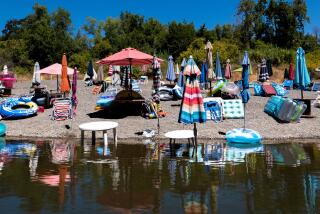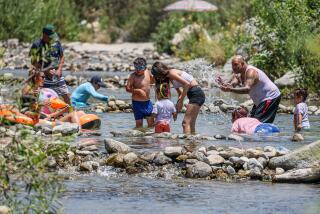Riverbed Back on List as Possible Commuter Route
- Share via
The bed of the Los Angeles River--which is occasionally used to film car chase scenes, train bus drivers and, during World War II, was utilized by Army trucks to rush munitions to the harbor--might someday be opened to commuters under a proposal being considered by county transportation planners.
The concrete “river,” which serves as a flood control channel, could handle commuter traffic as many as 300 days a year, experts say.
Transportation planners, searching for ways to relieve Los Angeles’ crowded freeways, have recommended that the Los Angeles County Transportation Commission authorize a $100,000 study of the feasibility of creating a river roadway that would be open to people in car and van pools and possibly also to trucks.
Subject for Study
The commission, which a few years ago studied but rejected a proposal to use the river for a light-rail line across the San Fernando Valley, will consider the latest suggestion June 28.
“It’s just an unstudied idea at this point,” said Jim Sims, the commission’s director of transportation programs.
“But the need for transportation relief is so great that we can’t afford to overlook anything that might work.”
Jean Granucci, spokeswoman for the Los Angeles County Public Works Department, which built and administers the county’s system of flood control channels, said proposals to use the concrete-lined rivers for transportation are “not new and when studied in the past were found not to be economical.”
But she said the need for traffic relief has become acute enough that “it should be looked at anew, provided that flood control is not impaired.”
The Los Angeles River begins just east of Canoga Park High School and meanders across the San Fernando Valley before turning south at Griffith Park, then passes east of downtown and heads straight to the harbor.
Sims said his staff has concluded, “subject to further study,” that the section between Canoga Park and downtown could best be used to carry car and van pools, but that buses would probably be too difficult to maneuver in and out of the riverbed.
Between downtown and the harbor, the riverbed “might best be utilized to carry heavy trucks” to get some of them off the Harbor and Long Beach freeways, Sims said.
Control of Water
He said the study, if authorized, also would cover the possibility of building walls on either side of the river’s low-flow channel, which is about six inches deep and five feet wide and almost always has water in it.
On rainy days, water now spills over the low-flow channel, which is in the middle of the riverbed. But the walls would give it a higher carrying capacity, meaning the number of days that the river could be used by commuters might be significantly expanded, Sims said.
Officials say the river road plan was resurrected a few months ago by Assemblyman Richard Katz (D-Panorama City), who approached county transportation planners with his idea.
Katz, chairman of the Assembly Transportation Committee, said Tuesday that if the plan proves feasible, the section between the San Fernando Valley and downtown could be in operation by 1991.
He foresees access to the river at Canoga Park, and at the intersections of the San Diego, Hollywood and Golden State freeways.
Although the plan needs further study, the possibility of using the riverbed is “just too good to pass up,” Katz said.
In response to Katz’s proposal, the commission staff has been gathering information on the channel, according to Vic Kamhi, a commission transportation analyst. In the process, he said, they learned about use of the riverbed to speed delivery of war materiel to the harbor--long before construction of the Harbor and Long Beach freeways.
“We have found many studies and much information,” Kamhi said. “Now we need someone to evaluate the data.”
The proposal might be stymied, Granucci said, by the fact that a section of the river bottom near Griffith Park is unpaved.
“When the rest of the river was lined with concrete in the 1950s,” Granucci said, “that section was left unpaved to allow replenishment of ground water.”
Other difficulties could include protecting motorists in the event of a rare flash flood.
And another problem could be Mayor Tom Bradley, who previously has supported a “greening” of the concrete-lined river by adding trees, shrubbery and open areas along its banks.
More to Read
Sign up for Essential California
The most important California stories and recommendations in your inbox every morning.
You may occasionally receive promotional content from the Los Angeles Times.










